The future of one of the largest wind farms ever proposed in Washington got a boost May 23 as Gov. Jay Inslee told a state panel it went too far downsizing the project.
Last month, the state’s energy facility siting panel sent Inslee its recommendation for approval of the Horse Heaven wind and solar project. It contained a raft of conditions that slashed the number of turbines in the Benton County project in half to curb threats to tribal cultural resources and endangered hawks.
Inslee on May 23 directed the Energy Facility Site Evaluation Council to revisit its decision and focus mitigation on “specific and narrowly tailored approaches” that will enable the wind farm “to achieve its full or near-full energy generation capacity.”
“Based on my review of the record and the potential impacts, mitigation measures that substantially reduce the generation capacity of the proposed project should not be required,” he said.
Inslee’s letter comes three days after Scout Clean Energy of Boulder, Colo., the company behind the effort, implored the council to take another look. The company said the panel’s restrictions would “gut” the project’s potential to produce power and, in doing so, jeopardize its viability.
“The Council has a chance to right the ship by reconsidering its decision,” it said
Coming to grips with change
The Horse Heaven wind and solar project is a massive undertaking proposed in a footprint spanning roughly 72,500 acres along Interstate 82 south of the Tri-Cities.
Scout submitted its project application three years ago. It called for up to 244 wind turbines and three solar arrays. The turbines were to be spaced along a 24-mile stretch with the solar panels covering about 5,500 acres.
In the ensuing environmental reviews and public hearings, concerns proliferated about the wind farm’s potential to alter the landscape, endanger wildlife habitats, threaten tribal cultural resources and disrupt the economy and character of nearby communities.
The siting council’s recommendation and conditions reportedly halve the number of turbines and shrink the spread of solar arrays. However, Scout said it’s not sure how many it can install because of a lack of clarity surrounding compliance with some mitigation measures.
In its decision, the council acknowledged the difficult trade-offs between heeding community concerns and fighting climate change by reducing Washington’s reliance on power generated from fossil fuels.
“Like all energy facilities, they will necessarily have impacts. The question is not whether all impacts must be avoided. They cannot be,” the council wrote in its recommendation to Inslee. “Instead, the question is whether all reasonable measures have been required to mitigate and minimize them with the full understanding of the tradeoffs and benefits.”
Washington is striving to end its reliance on electricity from fossil fuels such as coal by mid-century. To do that, it is counting on a rapid buildout of new clean energy generation and transmission projects like Horse Heaven.
That means readjusting the scale for these large-scale installations.
“We must come to grips with the fact that we will need to adapt and accept relatively moderate changes to our physical landscape, in order to ensure continued, reliable electricity service,” Inslee wrote.
In his letter, Inslee said the council’s conditions went too far removing turbine locations from large swaths of land identified as the historic nesting areas of the ferruginous hawks. Part of the reason, he said, is that none of the birds had been seen in the area in five years. If some return, he suggested construction could be halted in the spring and summer months when they may be nesting.
He also pushed for the council to work with tribes to identify the highest priority cultural resources, and modify conditions accordingly.
He downplayed the potential visual impacts, saying wind turbines “are a fairly common occurrence across the state. Adopting a zero-tolerance policy to visual impacts is inconsistent with state statutes. It is clear that turbines will be visible only from a distance and none of the turbines will loom over anyone’s home.”
Inslee directed the council to respond within 90 days after which the governor must then either approve or reject the project, according to his office.
Washington State Standard is part of States Newsroom, a nonprofit news network supported by grants and a coalition of donors as a 501c(3) public charity. Washington State Standard maintains editorial independence. Contact Editor Bill Lucia for questions: info@washingtonstatestandard.com. Follow Washington State Standard on Facebook and Twitter.






